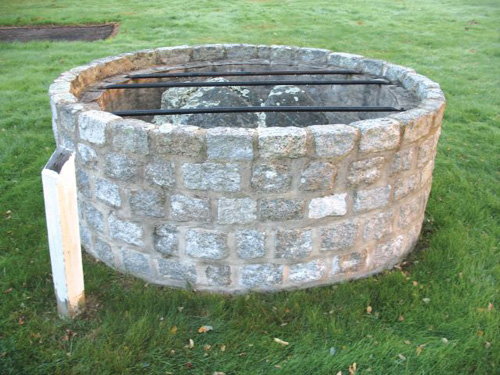Special to the Atlantic News
By John Hirtle, Production Manager
Atlantic News, Friday, October 6, 2006
[The following article is courtesy of Atlantic News]

Haunted Hampton
For a town that was founded by God-fearing Christians, Hampton has the most ghosts and witches rattling about its legendary landscape. The reasons why such supernatural forces choose congregate here are unclear. Perhaps it is the nature of the lovely landscape. Perhaps it is because the vacation brochures created by the chamber of commerce are more enticing than anyone could have ever guessed. Whatever the reason, you don’t have to search far two find two haunted tales of Hampton – through the manipulations of man, their very real artifacts lie close together near the heart of town.
On the grounds of the Tuck Museum on Park Avenue, there stands a short circular well that leads nowhere. The top is covered with iron bars to protect a large strangely marked boulder beneath it from the dangers of being toted away by souvenir hunters or careless construction workers.
According to the Viking Sagas, as the first Norsemen arrived in the New World, they made their way down the coast, exploring the new land. Sometime around 1004, Thorvald, the brother of the first Viking to arrive, Leif Ericsson, made his way down our uncharted coastline, admiring the land and trying to decide where to settle.
Somewhere along the trip, he seized and killed some Native Americans. Not too long after that, an even larger party of natives attacked Thorvald’s party and succeeded in mortally wounding him. Before Thorvald died, he asked to be buried near a headland, and his grave marked with a stone cut with crosses. So ended the tale.
Or did it?
Nine hundred years later, the Viking Sagas were coming to light, and suddenly traces of Vikings were being found all across North America, not only in New England and the Canadian Maritimes (where a Viking settlement has been discovered), but as far inland as Wisconsin and the Great Lakes. On July 4, 1902 the Hampton “Union” carried a story that in turn linked Hampton to the long dead Thorvald.
Charles M. Lamprey, whose family had owned the land in question since before 1672, penned the article which claimed that Great Boar’s Head must be the headland mentioned in the ancient saga, and on his property a large stone with strange markings sat in about the right place. Surely it must be Thorvald’s grave, he reasoned.
With scant evidence other than the strange, faint markings on the suddenly famous stone, Thorvald was heartily welcomed into Hampton’s history, where the tale was embellished and added to as time went by. Various authorities over the years have come forth to offer their own opinions on the markings on the silent boulder.
No mention was made of the fact that in 1902 Hampton was drawing in tourists by the thousands, and that the land in question had been sold to Wallace D. Lovell, the street-railway promoter, apparently had plans to build a Norse monument and park nearby. (Surfside Park does stand near the boulder’s former site.)
After years of study and excavations by many well-meaning people (and vandalism carried out by people who chipped pieces off of the rock, including an attempt to truck the entire thing off), the weary old stone was moved to the grounds of the Tuck Museum in 1989, and its present enclosure built to protect the unlikely artifact.
Most museum members will admit the odds of the boulder being authentic are scant at best, and most experts on the subject seem to think it more likely that Thorvald lies somewhere in Nova Scotia’s craggy landscape.
But who knows?
Simply put, the tale of Thorvald’s demise in Hampton remains in circulation because it is just too good to abandon to the cold hard facts of reality.


(Photo above:) This is Thorvald’s tombstone.
This otherwise unremarkable boulder once stood on Ash Street near Thorvald Avenue, not too far from Great Boar’s Head, a large headland that juts out into the Atlantic, and seemed to fit the description of a place in an ancient tale written down before America had a name.
The Viking figurehead (photo left) is from the “Icelander” a reproduction Viking longship that visited Portsmouth, NH, back in 2000 or so…